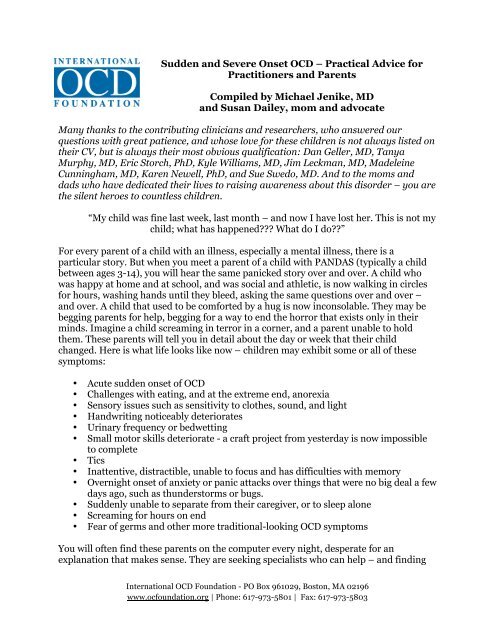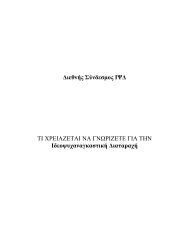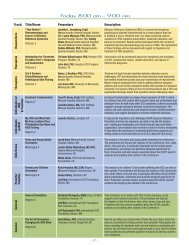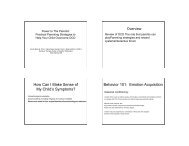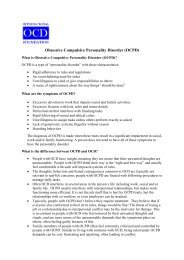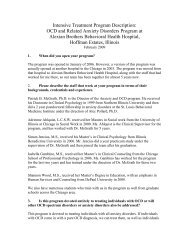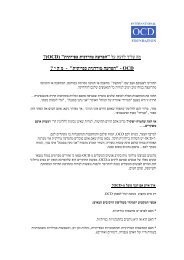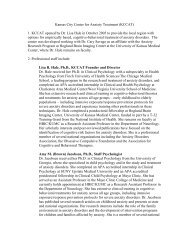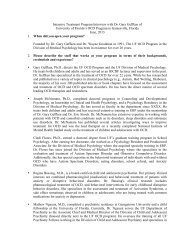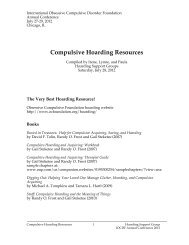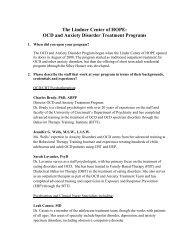Expert Opinion Article on PANDAS - Obsessive Compulsive ...
Expert Opinion Article on PANDAS - Obsessive Compulsive ...
Expert Opinion Article on PANDAS - Obsessive Compulsive ...
Create successful ePaper yourself
Turn your PDF publications into a flip-book with our unique Google optimized e-Paper software.
Sudden and Severe Onset OCD – Practical Advice for<br />
Practiti<strong>on</strong>ers and Parents<br />
Compiled by Michael Jenike, MD<br />
and Susan Dailey, mom and advocate<br />
Many thanks to the c<strong>on</strong>tributing clinicians and researchers, who answered our<br />
questi<strong>on</strong>s with great patience, and whose love for these children is not always listed <strong>on</strong><br />
their CV, but is always their most obvious qualificati<strong>on</strong>: Dan Geller, MD, Tanya<br />
Murphy, MD, Eric Storch, PhD, Kyle Williams, MD, Jim Leckman, MD, Madeleine<br />
Cunningham, MD, Karen Newell, PhD, and Sue Swedo, MD. And to the moms and<br />
dads who have dedicated their lives to raising awareness about this disorder – you are<br />
the silent heroes to countless children.<br />
“My child was fine last week, last m<strong>on</strong>th – and now I have lost her. This is not my<br />
child; what has happened What do I do”<br />
For every parent of a child with an illness, especially a mental illness, there is a<br />
particular story. But when you meet a parent of a child with <strong>PANDAS</strong> (typically a child<br />
between ages 3-14), you will hear the same panicked story over and over. A child who<br />
was happy at home and at school, and was social and athletic, is now walking in circles<br />
for hours, washing hands until they bleed, asking the same questi<strong>on</strong>s over and over –<br />
and over. A child that used to be comforted by a hug is now inc<strong>on</strong>solable. They may be<br />
begging parents for help, begging for a way to end the horror that exists <strong>on</strong>ly in their<br />
minds. Imagine a child screaming in terror in a corner, and a parent unable to hold<br />
them. These parents will tell you in detail about the day or week that their child<br />
changed. Here is what life looks like now – children may exhibit some or all of these<br />
symptoms:<br />
• Acute sudden <strong>on</strong>set of OCD<br />
• Challenges with eating, and at the extreme end, anorexia<br />
• Sensory issues such as sensitivity to clothes, sound, and light<br />
• Handwriting noticeably deteriorates<br />
• Urinary frequency or bedwetting<br />
• Small motor skills deteriorate - a craft project from yesterday is now impossible<br />
to complete<br />
• Tics<br />
• Inattentive, distractible, unable to focus and has difficulties with memory<br />
• Overnight <strong>on</strong>set of anxiety or panic attacks over things that were no big deal a few<br />
days ago, such as thunderstorms or bugs.<br />
• Suddenly unable to separate from their caregiver, or to sleep al<strong>on</strong>e<br />
• Screaming for hours <strong>on</strong> end<br />
• Fear of germs and other more traditi<strong>on</strong>al-looking OCD symptoms<br />
You will often find these parents <strong>on</strong> the computer every night, desperate for an<br />
explanati<strong>on</strong> that makes sense. They are seeking specialists who can help – and finding<br />
Internati<strong>on</strong>al OCD Foundati<strong>on</strong> - PO Box 961029, Bost<strong>on</strong>, MA 02196<br />
www.ocfoundati<strong>on</strong>.org | Ph<strong>on</strong>e: 617-973-5801 | Fax: 617-973-5803
no answers. They are starting to feel crazy themselves, because no <strong>on</strong>e seems to believe<br />
what they are going through.<br />
If you are a pediatrician or pediatric therapist faced with this family in your office, this<br />
may look daunting. However, let’s take a minute to walk through opti<strong>on</strong>s that are<br />
available to parents, medical and mental health professi<strong>on</strong>als, and kids suffering from<br />
this disorder. These treatment recommendati<strong>on</strong>s were developed from interviewing<br />
clinicians and researchers around the country, so that you can potentially stop the<br />
disease in its tracks while you referring these children for additi<strong>on</strong>al help if needed.<br />
What is Pediatric Autoimmune Neuropsychiatric Disorder Associated with<br />
Strep or <strong>PANDAS</strong><br />
<strong>PANDAS</strong> was defined in 1998 by Dr. Sue Swedo. Over the prior decade, Dr. Swedo had<br />
been studying Sydenham Chorea where 70% of patients exhibit sudden <strong>on</strong>set OCD<br />
symptoms before or after this classic movement disorder. She and other researchers<br />
were finding children who had sudden <strong>on</strong>set OCD symptoms without the carditis (heart<br />
inflammati<strong>on</strong>) or movement disorder normally characteristic of Sydenham Chorea and<br />
acute rheumatic fever.<br />
Auto-antibodies have been implicated in the carditis of Acute Rheumatic Fever, and Dr.<br />
Swedo theorized that perhaps a related set of antibodies were mistakenly attacking the<br />
basal ganglia (part of the brain) rather than the intended streptococcal bacteria<br />
triggering the movement disorder/sudden <strong>on</strong>set of OCD. In July 2010, researchers met<br />
at the NIH to discuss the past decade of clinical findings. Of significance, the panel<br />
found that while strep throat seems to be a trigger, it may not be the <strong>on</strong>ly trigger.<br />
Sudden <strong>on</strong>set OCD could be triggered by other diseases, including Lyme, M<strong>on</strong>o,<br />
Mycoplasma and the flu virus (such as H1N1). Based <strong>on</strong> this and other clinical reports,<br />
the panel modified the research definiti<strong>on</strong> of <strong>PANDAS</strong>.<br />
How to Identify a <strong>PANDAS</strong> Child<br />
Sudden dramatic <strong>on</strong>set is the most salient characteristic and differentiates <strong>PANDAS</strong><br />
from a more frequent pediatric OCD presentati<strong>on</strong> - which involves subclinical symptoms<br />
becoming gradually more severe. Incapacitating fears and anxieties seem to come <strong>on</strong><br />
“overnight” with many parents being able to name the exact day when their child<br />
changed. In additi<strong>on</strong>, while the mean age of OCD in children is between 9 and 10 years<br />
of age, <strong>PANDAS</strong> cases can start at a younger age such as 5 or 6, often corresp<strong>on</strong>ding<br />
with a diagnosis of strep.<br />
Physicians are encouraged to assess for:<br />
• A history of sore throat, fever, exudative pharyngitis, cervical adenopathy<br />
(enlarged and tender lymph nodes in the neck), enlarged or damaged t<strong>on</strong>sils<br />
• Atypical presentati<strong>on</strong>s of strep, especially in young children, include abdominal<br />
pain and vomiting, vaginal or perianal redness<br />
Internati<strong>on</strong>al OCD Foundati<strong>on</strong> - PO Box 961029, Bost<strong>on</strong>, MA 02196<br />
www.ocfoundati<strong>on</strong>.org | Ph<strong>on</strong>e: 617-973-5801 | Fax: 617-973-5803
• In some cases of <strong>PANDAS</strong>, the strep appeared to be “hiding” in the sinuses or<br />
middle ear resulting in a negative throat culture<br />
• It is also possible that n<strong>on</strong>-strep organisms can cause a similar neuropsychiatric<br />
illness in vulnerable children. Therefore, it is important to check for mycoplasma,<br />
m<strong>on</strong>o, or exposure to Lyme disease.<br />
During the meeting at NIH last year, researchers and clinicians across the country began<br />
to revise the criteria defining this illness in children. Based <strong>on</strong> that c<strong>on</strong>ference, because<br />
there are n<strong>on</strong>-strep causes of sudden <strong>on</strong>set illness, researchers changed the name of the<br />
disease to PANS: Pediatric Acute-Onset Neuropsychiatric Syndrome.<br />
Mental and medical professi<strong>on</strong>als should look for:<br />
• Abrupt, dramatic <strong>on</strong>set of OCD is the first diagnostic criteri<strong>on</strong> for PANS. For<br />
those familiar with the CYBOCS (Childhood Yale Brown <strong>Obsessive</strong> <strong>Compulsive</strong><br />
Scale) scores, some clinicians look for an increase in total score of more than 16<br />
in the course of a few days. Children may have mild “quirks” or even some signs<br />
of OCD prior to this abrupt dramatic <strong>on</strong>set. In retrospect some clinicians suggest<br />
that mild micro-episodes may even have occurred in the past. However, in the<br />
space of a few days, they “fall off a cliff”, dramatically causing a significant<br />
decrease in the child’s ability to functi<strong>on</strong>. Impairment is significant. Parents can<br />
usually name the day that the crisis occurred and have vivid memories of the first<br />
obsessi<strong>on</strong>s or compulsi<strong>on</strong>s because of their extreme nature. As an example, a<br />
normally joyful, balanced emoti<strong>on</strong>ally, independent, social child may turn into a<br />
child that has extreme temper tantrums that are out of character, and can no<br />
l<strong>on</strong>ger leave a parent’s side without accommodati<strong>on</strong>. Panic attacks and unusual<br />
anxieties are not uncomm<strong>on</strong>. In additi<strong>on</strong> to the typical obsessi<strong>on</strong>al fears and<br />
compulsive behaviors, this criteri<strong>on</strong> also may be satisfied by the sudden severe<br />
<strong>on</strong>set of food avoidance, anorexia and eating restricti<strong>on</strong>s. Clinically, these occur<br />
as solitary symptoms am<strong>on</strong>g PANS patients, as well as from complicati<strong>on</strong>s<br />
resulting from obsessi<strong>on</strong>al fears of choking, vomiting or of c<strong>on</strong>taminated foods.<br />
• Although there appears to be uniformity in the acuity and severity of <strong>on</strong>set of the<br />
co-occurring symptoms, there is great variability in the nature of the symptoms<br />
accompanying the OCD. As a result, the sec<strong>on</strong>d major criteri<strong>on</strong> for PANS is the<br />
c<strong>on</strong>current acute <strong>on</strong>set of additi<strong>on</strong>al symptoms from at least two of the following<br />
seven categories:<br />
1. anxiety (particularly acute separati<strong>on</strong> anxiety and irrati<strong>on</strong>al fears)<br />
2. emoti<strong>on</strong>al lability and/or depressi<strong>on</strong><br />
3. irritability, aggressi<strong>on</strong> and/or oppositi<strong>on</strong>al behaviors<br />
4. behavioral (developmental) regressi<strong>on</strong><br />
5. sudden deteriorati<strong>on</strong> in school performance<br />
6. sensory or motor abnormalities (particularly dysgraphia/ trouble with<br />
handwriting)<br />
7. somatic/physical signs and symptoms<br />
Internati<strong>on</strong>al OCD Foundati<strong>on</strong> - PO Box 961029, Bost<strong>on</strong>, MA 02196<br />
www.ocfoundati<strong>on</strong>.org | Ph<strong>on</strong>e: 617-973-5801 | Fax: 617-973-5803
As in most of psychiatry, PANS is a clinical diagnosis, meaning that there are currently<br />
no laboratory or genetic tests that can c<strong>on</strong>firm the diagnosis. As such, a sec<strong>on</strong>d opini<strong>on</strong><br />
to find c<strong>on</strong>sensus <strong>on</strong> the diagnosis of PANS between two experienced physicians may be<br />
useful.<br />
Additi<strong>on</strong>al Medical Testing to C<strong>on</strong>sider Prior to Onset of Treatment<br />
Many physicians report that a throat culture appears to be key (even if there are no signs<br />
or symptoms of pharyngitis). Due to the difficulty in properly sampling these children, a<br />
two-swab sample should be taken to check for bacterial col<strong>on</strong>izati<strong>on</strong>. The first swab<br />
should be a rapid strep test. It is very important that the culture is obtained properly by<br />
vigorously swabbing across the entire pharynx, behind both t<strong>on</strong>sils and the uvula. If the<br />
child doesn’t gag and protest, the swab is probably inadequate. If negative, use the<br />
sec<strong>on</strong>d swab for a 4-hour agar plate culture. If these are both negative, c<strong>on</strong>sider testing<br />
for Lyme disease, Mycoplasma, vitamin D, Ferritin and thyroid. Many children with<br />
recurrent upper respiratory infecti<strong>on</strong>s have immune deficiencies and would benefit from<br />
an immune functi<strong>on</strong> assessment such as blood counts measuring quantitative<br />
immunoglobulins and a referral to a pediatric immunologist.<br />
Finally, many physicians rely <strong>on</strong> antibodies to the exotoxins of streptococcus to c<strong>on</strong>firm<br />
a prior infecti<strong>on</strong> measuring ASO and AntiDNaseB. These tests have fixed windows<br />
where the measurement may begin to be positive 1-8 weeks after initial infecti<strong>on</strong>.<br />
Typically two measurements are required. The first should be obtained as so<strong>on</strong> as<br />
possible after the suspected infecti<strong>on</strong> and the sec<strong>on</strong>d at least six weeks later. It is<br />
currently unknown whether carrying the bacteria without an active infecti<strong>on</strong> al<strong>on</strong>e is<br />
sufficient to cause symptoms in PANS children.<br />
If test results are all normal, it does not rule out a diagnosis of PANS, and exposure to<br />
infecti<strong>on</strong>s from close c<strong>on</strong>tacts should be c<strong>on</strong>sidered.<br />
Treatment Opti<strong>on</strong>s and Strategies to C<strong>on</strong>sider for PANS<br />
While acknowledging the need for additi<strong>on</strong>al research, we also cannot sit idly by while<br />
children scream in terror. We have to help children suffering today. Clinicians around<br />
the country have started treating our kids. Best practices suggest that <strong>on</strong>e develop a<br />
treatment plan based <strong>on</strong> interventi<strong>on</strong>s with the minimum effective dose, an interventi<strong>on</strong><br />
with the best cost/benefit ratio (less intrusive, minimal short term and l<strong>on</strong>g term side<br />
effects, good at preventing relapse, easy to administer, tolerated well) and treatments<br />
that have the most research behind them. Research can include c<strong>on</strong>trolled studies<br />
(better) and case reports (good but less informative). We will rate each of the following<br />
treatments currently being used as a guide for professi<strong>on</strong>als and parents to c<strong>on</strong>sider<br />
when trying to determine the best course of acti<strong>on</strong>. This is said with the caveat that at<br />
this point in time <strong>PANDAS</strong> and PANS treatments are drastically under researched.<br />
Please see the end of this article for more about how to help <strong>on</strong> this fr<strong>on</strong>t.<br />
IVIG: The original research studies investigating possible treatment opti<strong>on</strong>s were d<strong>on</strong>e<br />
by giving children IVIG (intravenous immunoglobin). Essentially, this treatment gives a<br />
Internati<strong>on</strong>al OCD Foundati<strong>on</strong> - PO Box 961029, Bost<strong>on</strong>, MA 02196<br />
www.ocfoundati<strong>on</strong>.org | Ph<strong>on</strong>e: 617-973-5801 | Fax: 617-973-5803
child antibodies from a myriad of d<strong>on</strong>ors. We d<strong>on</strong>’t know exactly how IVIG works, but it<br />
appears to help in a number of autoimmune illnesses.<br />
In <strong>PANDAS</strong>, IVIG reduced the OCD symptom severity for 82% of children suspected of<br />
having <strong>PANDAS</strong> in a small study<br />
(http://intramural.nimh.nih.gov/pdn/pubs/pub-5.pdf) that is now being<br />
repeated at the NIH (http://clinicalstudies.info.nih.gov/cgi/detail.cgiA_2011-<br />
M-0058.html). IVIG is offered to children in a clinical envir<strong>on</strong>ment – but is often not<br />
covered by insurance and is expensive. While IVIG is usually c<strong>on</strong>sidered quite safe for<br />
treating auto-immune disorders, there are several risks. Nausea, vomiting, and<br />
headache are not uncomm<strong>on</strong> and in rare instances, aseptic meningitis or allergic<br />
reacti<strong>on</strong>s may occur. Although most side effects are not harmful in the l<strong>on</strong>g term, they<br />
are unpleasant and therefore IVIG therapy is generally recommended <strong>on</strong>ly for severe or<br />
persistent cases or as indicated for immune deficiency disorders.<br />
Antibiotics: Dr. Swedo also did research showing that using antibiotics as a<br />
prophylaxis to prevent strep successfully reduces neuropsychiatric exacerbati<strong>on</strong>s<br />
(http://www.ncbi.nlm.nih.gov/pubmed/15820236). Another study will start so<strong>on</strong> as a<br />
collaborati<strong>on</strong> between Harvard and the University of South Florida. They will be<br />
examining a comm<strong>on</strong> treatment course successfully used by clinicians: using antibiotics<br />
in children with <strong>PANDAS</strong>. Early in the disease if strep is present, this is an obvious<br />
course. But no research has yet been d<strong>on</strong>e <strong>on</strong> why many clinicians find that a l<strong>on</strong>ger<br />
term course of antibiotics often seems to offer great hope to families suffering from this<br />
disease –even after the actual triggering illness is over.<br />
As such, some physicians have found the following particularly helpful for new, sudden<br />
<strong>on</strong>set cases:<br />
• Use antibiotics for 3-6 weeks initially. Use of augmentin has anecdotally been<br />
found to be more effective at a relatively high dose as well as the<br />
cephalosporins (cephalexin, cefdinir) and azithromycin. C<strong>on</strong>sider using<br />
probiotics but not at same time of the day; allow 2-3 hour window between. If<br />
no improvement is seen after 3-4 weeks, a physician may c<strong>on</strong>sider an<br />
alternate class of antibiotic treatment. If symptoms completely remit, a trial<br />
off the antibiotic may be attempted. If symptoms return, additi<strong>on</strong>al treatment<br />
may be warranted.<br />
However, in many cases, a physician will see a child a several weeks after the initial<br />
<strong>on</strong>set, or in a sec<strong>on</strong>d exacerbati<strong>on</strong>. In that case, some clinicians have recommended the<br />
following:<br />
• A throat culture can still be very informative at this point as well as antibody<br />
levels. Then treat with antibiotics as above while waiting for the results. If<br />
there is a marked reducti<strong>on</strong> in symptoms, gradually wean. With a recurrence,<br />
antibiotics are reintroduced and c<strong>on</strong>tinued as needed. Try to gather<br />
retrospective informati<strong>on</strong>, ask for detailed pediatrician records to be<br />
forwarded and nail down the exact timing of testing and labs. Since prior<br />
testing may have been limited, a trial of antibiotics appears to be low risk.<br />
Internati<strong>on</strong>al OCD Foundati<strong>on</strong> - PO Box 961029, Bost<strong>on</strong>, MA 02196<br />
www.ocfoundati<strong>on</strong>.org | Ph<strong>on</strong>e: 617-973-5801 | Fax: 617-973-5803
Exposure and Resp<strong>on</strong>se Preventi<strong>on</strong> (an interventi<strong>on</strong> under the broader<br />
umbrella “Cognitive Behavior Therapy or CBT): Unlike traditi<strong>on</strong>al <strong>on</strong>set OCD,<br />
where research clearly guides a mental health and medical professi<strong>on</strong>al’s decisi<strong>on</strong><br />
making about how to proceed with treatment, PANS <strong>on</strong>set OCD is still under<br />
researched. As we wait for studies to be completed we still need to develop treatment<br />
strategies that can address the pain and suffering of children and families now. For<br />
many PANS children, the suddenness of <strong>on</strong>set and the migratory nature of the<br />
obsessi<strong>on</strong>s/compulsi<strong>on</strong>s can make Exposure and Resp<strong>on</strong>se Preventi<strong>on</strong> therapy or ERP<br />
challenging; however, a combinati<strong>on</strong> of a medical interventi<strong>on</strong> and traditi<strong>on</strong>al ERP<br />
might be the best course of acti<strong>on</strong> at this point in time. For some children an initial<br />
treatment with antibiotics or IVIG results in significant relief of symptoms. For those<br />
with slow or partial remissi<strong>on</strong> of symptoms, ensuring that ERP is included seems to be<br />
critical. Children develop habits and fears quickly and they may use ERP treatment to<br />
teach their brain to ignore the irrati<strong>on</strong>al fear signals they have been receiving. ERP<br />
teaches a child c<strong>on</strong>crete tools to overcome OCD thoughts <strong>on</strong> a daily basis. Many<br />
clinicians find that learning ERP allows the entire family to functi<strong>on</strong> more calmly during<br />
future exacerbati<strong>on</strong>s, while seeking medical help. Some recent but preliminary work by<br />
a group at University of South Florida found str<strong>on</strong>g effects for this approach in children<br />
with <strong>PANDAS</strong> (Drs. Storch & Murphy).<br />
SSRIs: Most clinicians experienced in treating children with <strong>PANDAS</strong> do not initially<br />
recommend SSRIs, especially given the very young age of many of the children.<br />
However, as the disease course c<strong>on</strong>tinues, they may find relief with the use of SSRIs in<br />
much lower doses than is normally recommended for children with OCD. Close<br />
m<strong>on</strong>itoring is str<strong>on</strong>gly recommended, as very young children may have more adverse<br />
behavioral or neurological effects. Occasi<strong>on</strong>ally, mood stabilizers have been reported as<br />
helpful, as the presence of mood volatility in PANS/<strong>PANDAS</strong> is a major limitati<strong>on</strong> in the<br />
use of SSRIs. Please see this link for more informati<strong>on</strong>:<br />
http://www.primarypsychiatry.com/aspx/articledetail.aspxarticleid=561<br />
Plasmapherisis: Dr. Swedos’ original study included both IVIG and plasmapherisis.<br />
Plasmapherisis was the more immediate and effective opti<strong>on</strong> in the original study.<br />
However, as the most expensive and invasive treatment opti<strong>on</strong>, this is rarely used in a<br />
clinical setting, and is bey<strong>on</strong>d the scope of this article. For more informati<strong>on</strong>, see the<br />
original research study http://intramural.nimh.nih.gov/pdn/pubs/pub-5.pdf,<br />
or read more about plasmapherisis <strong>on</strong>line:.<br />
Steroids: As with all autoimmune diseases, doctors have found that anti-inflammatory<br />
medicati<strong>on</strong>s (such as corticosteroids) can be effective in both short and l<strong>on</strong>g term use.<br />
However, these can be very damaging to children in l<strong>on</strong>g-term use and should <strong>on</strong>ly be<br />
c<strong>on</strong>sidered in careful c<strong>on</strong>sultati<strong>on</strong>. Some parents or clinicians have found that shortterm<br />
use of steroids can help auto-immune, triggered OCD <strong>on</strong>ce the initial infecti<strong>on</strong> is<br />
cleared. Behavioral side effects are sometimes seen in steroid therapies (especially mood<br />
symptoms) and can overlap with PANS symptoms. Should additi<strong>on</strong>al research studies<br />
come available, IOCDF will publish those findings.<br />
Internati<strong>on</strong>al OCD Foundati<strong>on</strong> - PO Box 961029, Bost<strong>on</strong>, MA 02196<br />
www.ocfoundati<strong>on</strong>.org | Ph<strong>on</strong>e: 617-973-5801 | Fax: 617-973-5803
Ibuprofen and NSAIDs: Some parents have reported that n<strong>on</strong>-steroid antiinflammatories<br />
(such as Ibuprofen) do seem to help symptoms. This has led some<br />
researchers to c<strong>on</strong>sider that perhaps it is the anti-inflammatory effects of the antibiotics,<br />
IVIG and steroids <strong>on</strong> the blood-brain barrier that is resulting in improved symptoms.<br />
While l<strong>on</strong>g-term use of NSAIDs carries its own issues, some pediatricians prescribe a<br />
low-dose NSAID during significant episodes. Please c<strong>on</strong>sult with your doctor as there<br />
are multiple other issues to c<strong>on</strong>sider when using this approach.<br />
Summary, C<strong>on</strong>clusi<strong>on</strong>s, and Going Forward<br />
As noted previously, in the absence of research, we cannot recommend doing nothing<br />
for these children. Their suffering is intense. And the risk of l<strong>on</strong>g-term damage cannot<br />
be ignored. We also do not know if some of these children remit sp<strong>on</strong>taneously later in<br />
adolescence. We do not know if some of them grow into adults with the most treatment<br />
resistant OCD due to permanent basal ganglia damage. While we research those<br />
questi<strong>on</strong>s, offering treatment opti<strong>on</strong>s at the local level, especially in the first few m<strong>on</strong>ths<br />
after <strong>on</strong>set, could be critical to the l<strong>on</strong>g term success for these kids. One prospective<br />
study c<strong>on</strong>ducted in a pediatrician’s office suggests that first-<strong>on</strong>set <strong>PANDAS</strong> symptoms<br />
may remit following successful treatment of the strep infecti<strong>on</strong> with antibiotics.<br />
Unfortunately, there has not been a follow-up report <strong>on</strong> these children, so it is unknown<br />
if some children experience a sec<strong>on</strong>d exacerbati<strong>on</strong> following successful treatment of the<br />
initial <strong>on</strong>set of <strong>PANDAS</strong> symptoms.<br />
Like Sydenham Chorea, PANS provides a window into a whole new way of treating<br />
mental illness as a faulty immune resp<strong>on</strong>se. There are many researchers across the<br />
nati<strong>on</strong> who have developed hypotheses about the cause, c<strong>on</strong>tributing factors, and<br />
treatment. They need funding to move forward with this seed research, before<br />
developing larger grant proposals. If you are interested in learning more, or in<br />
c<strong>on</strong>tributing towards this research, the IOCDF welcomes your call or d<strong>on</strong>ati<strong>on</strong>. Dr.<br />
Madeleine Cunningham often ends her presentati<strong>on</strong>s <strong>on</strong> <strong>PANDAS</strong> with this compelling<br />
quote: "If auto-antibodies are proven to play a role in mental disorders, then<br />
it will change the way mental illness is diagnosed and treated forever." Being<br />
a part of this change - whether you are a treating physician, a researcher, a parent or a<br />
d<strong>on</strong>or – might change your life forever too.<br />
Additi<strong>on</strong>al reading:<br />
What every Psychiatrist should know about <strong>PANDAS</strong>:<br />
http://www.cpementalhealth.com/c<strong>on</strong>tent/4/1/13<br />
References:<br />
1. S Swedo et al, “<strong>Obsessive</strong>-<strong>Compulsive</strong> Disorder in Children and Adolescents :<br />
Clinical Phenomenology of 70 C<strong>on</strong>secutive Cases ”, Arch Gen Psychiatry.<br />
1989;46(4):335-341.<br />
http://archpsyc.ama-assn.org/cgi/c<strong>on</strong>tent/abstract/46/4/335<br />
2. Giedd JN, Rapoport JL, Kruesi MJ, et al. Sydenham's chorea: magnetic<br />
res<strong>on</strong>ance imaging of the basal ganglia. Neurology 1995; 45:2199-202.<br />
Internati<strong>on</strong>al OCD Foundati<strong>on</strong> - PO Box 961029, Bost<strong>on</strong>, MA 02196<br />
www.ocfoundati<strong>on</strong>.org | Ph<strong>on</strong>e: 617-973-5801 | Fax: 617-973-5803
3. Castillo M, Kwock L, Arbelaez A. Sydenham's chorea: MRI and prot<strong>on</strong><br />
spectroscopy. Neuroradiology 1999; 41:943-5.<br />
4. Giedd JN, Rapoport JL, Garvey MA, Perlmutter S, Swedo SE. MRI assessment of<br />
children with obsessive-compulsive disorder or tics associated with streptococcal<br />
infecti<strong>on</strong>. Am J Psychiatry 2000; 157:281-3.<br />
5. Debes NMM, Hansen A, Liselott S, Larss<strong>on</strong> H. “A functi<strong>on</strong>al Magnetic Res<strong>on</strong>ance<br />
Imaging Stufy of a Large Clinical Cohort of Children with Tourette Syndrome.”, J<br />
Child Neurol May 2011 vol. 26 no. 5 560-569,<br />
http://jcn.sagepub.com/c<strong>on</strong>tent/26/5/560.abstract<br />
6. Khurana DS, Melvin J, Kothare S, et al. “Acute Disseminated Encephalomyelitis<br />
in Children: Discordant Neurologic and Neuroimaging Abnormalities and<br />
Resp<strong>on</strong>se to Plasmaphereisis”, Pediatrics Vol. 116 No. 2 August 1, 2005, pp 431-<br />
436. http://pediatrics.aappublicati<strong>on</strong>s.org/c<strong>on</strong>tent/116/2/431.abstract<br />
7. Sahlas DJ, Miller, SP, Guerin M, et al. “Treatment of acute disseminated<br />
encephalomyelitis with intravenous immunoglobulin.”, Neurology, March 28,<br />
2000; vol. 54. No 6. 1370-1372.<br />
http://www.neurology.org/c<strong>on</strong>tent/54/6/1370.abstract<br />
8. Calabrese G, Columbo C, B<strong>on</strong>fanti A, et al, “Caudate nucleus abnormalities in<br />
obsessive-compulsive disorder: measurements of MRI signal intensity.”<br />
Psychiatry Res, 1993 Jun; 50(2):89-92.<br />
http://www.ncbi.nlm.nih.gov/pubmed/8378491dopt=Abstract<br />
9. Crespo-Facorro B, Cabranes JA, Lopez-Ibor A, et al. Regi<strong>on</strong>al cerebral blood flow<br />
in obsessive-compulsive patients with and without a chr<strong>on</strong>ic tic disorder. A<br />
SPECT study. European Archives of Psychiatry and Clinical Neuroscience, 1999,<br />
Volume 249, Number 3, Pages 156-161<br />
http://www.springerlink.com/c<strong>on</strong>tent/0qjlav855g59cp8x/<br />
10. Hurley R, Taber K, “Acute and Chr<strong>on</strong>ic Lyme Disease: C<strong>on</strong>troversies for<br />
Neuropsychiatry.” J. Neuropsychiatry Clin Neurosci 20;iv-6, Feb 2008,<br />
http://neuro.psychiatry<strong>on</strong>line.org/cgi/c<strong>on</strong>tent/full/20/1/iv<br />
11. Zomorrodi A, Wald, E. “Sydenham’s Chorea in Western Pennsylvania.” Pediatrics<br />
Vol. 117 No. 4 April 1, 2006, pp e675-e679.<br />
http://pediatrics.aappublicati<strong>on</strong>s.org/c<strong>on</strong>tent/117/4/e675.full<br />
12. Murphy T, Kurlan R, Leckman J, “The immunobiology of Tourette’s Disorder,<br />
Pedeiatric Autoimmune Neuropsychiatric Disorders Associated with<br />
Streptococcus, and Relatd Disorders: A way forward”. J of Child and Adolescent<br />
Psychopharmacology, Volume 20, Number 4, 2010. Pp 317-331.<br />
http://www.njcts.org/docs/ImmunobiologyofTDand<strong>PANDAS</strong>.pdf<br />
13. Allen AJ, Le<strong>on</strong>ard HL, Swedo SE. Case study: a new infecti<strong>on</strong>-triggered,<br />
autoimmune subtype of pediatric OCD and Tourette's syndrome. J Am Acad<br />
Child Adolesc Psychiatry 1995; 34:307-11.<br />
http://www.ncbi.nlm.nih.gov/pubmed/7896671<br />
14. Nicols<strong>on</strong> et al, "An Open Trial of Plasma Exchange in Childhood Onset<br />
<strong>Obsessive</strong>-compulsive Disorder Without Poststreptococcal Exacerbati<strong>on</strong>s. " J Am<br />
Acad Child Adolesc Psychiatry 2000, 39[10]: 1313-1315<br />
http://www.ncbi.nlm.nih.gov/pubmed/11026187<br />
Internati<strong>on</strong>al OCD Foundati<strong>on</strong> - PO Box 961029, Bost<strong>on</strong>, MA 02196<br />
www.ocfoundati<strong>on</strong>.org | Ph<strong>on</strong>e: 617-973-5801 | Fax: 617-973-5803
15. S Swedo et al, "Identificati<strong>on</strong> of Children With Pediatric Autoimmune<br />
Neuropsychiatric Disorders Associated With Streptococcal Infecti<strong>on</strong>s by a Marker<br />
Associated With Rheumatic Fever", Am J Psychiatry 154:1, January 1997<br />
http://ajp.psychiatry<strong>on</strong>line.org/cgi/reprint/154/1/110.pdf<br />
16. Swedo SE, Le<strong>on</strong>ard HL, Rapoport JL." The pediatric autoimmune<br />
neuropsychiatric disorders associated with streptococcal infecti<strong>on</strong> (<strong>PANDAS</strong>)<br />
subgroup: separating fact from ficti<strong>on</strong>", Pediatrics. 2004 Apr;113(4):907-11.<br />
http://pediatrics.aappublicati<strong>on</strong>s.org/cgi/reprint/113/4/907<br />
17. Moretti G, Pasquini M, Mandarelli G, Tarsitani L, Bi<strong>on</strong>di M (2008). "What every<br />
psychiatrist should know about <strong>PANDAS</strong>: a review". Clin Pract Epidemol Ment<br />
Health 4: 13.<br />
http://www.ncbi.nlm.nih.gov/pmc/articles/PMC2413218/pdf/1745-0179-4-<br />
13.pdf<br />
18. Swedo SE et al., "Pediatric Autoimmune Neuropsychiatric Disorders Associated<br />
With Streptococcal Infecti<strong>on</strong>s: Clinical Descripti<strong>on</strong> of the First 50 Cases", Am J<br />
Psychiatry 155:2, February 1998.<br />
http://ajp.psychiatry<strong>on</strong>line.org/cgi/reprint/155/2/264<br />
19. Shet A, Kaplan EL, Johns<strong>on</strong> DR, Cleary PP, "Immune resp<strong>on</strong>se to group A<br />
streptococcal C5a peptidase in children: implicati<strong>on</strong>s for vaccine development", J<br />
Infect Dis. 2003 Sep 15;188(6):809-17.<br />
http://www.journals.uchicago.edu/doi/pdf/10.1086/377700<br />
20. Storch EA, Murphy TK, Geffken, G et al, "Cognitive-Behavioral Therapy for<br />
<strong>PANDAS</strong>-Related <strong>Obsessive</strong>-<strong>Compulsive</strong> Disorder: Findings From a Preliminary<br />
Waitlist C<strong>on</strong>trolled Open Trial", Journal of the American Academy of Child &<br />
Adolescent Psychiatry: October 2006 - Volume 45 - Issue 10 - pp 1171-1178<br />
http://www.ncbi.nlm.nih.gov/pubmed/17003662<br />
21. Murphy TK, Storch EA, Strawser MS, "Selective serot<strong>on</strong>in reuptake inhibitorinduce<br />
behavioral activati<strong>on</strong> in the <strong>PANDAS</strong> subtype", Primary Psychiatry,<br />
2006;13(8):87-89, http://mbldownloads.com/0806PP_Murphy.pdf<br />
22. Perlmutter SJ, Leitman SF, Garvey MA, "Therapeutic plasma exchange and<br />
intravenous immunoglobulin for obsessive-compulsive disorder and tic disorders<br />
in childhood", Lancet 1999; 354 : 1153 – 58<br />
http://intramural.nimh.nih.gov/pdn/pubs/pub-5.pdf<br />
23. Snider L, Lougee L, Slattery M, Grant P, Swedo S. "Antibiotic prophylaxis with<br />
azithromycin or penicillin for childhood-<strong>on</strong>set neuropsychiatric disorders". Biol<br />
Psychiatry 57 (7): 788–92. 2005 http://intramural.nimh.nih.gov/pdn/pubs/pub-<br />
9.pdf<br />
24. Schneider R., Robins<strong>on</strong> M., Levens<strong>on</strong> J., "Psychiatric presentati<strong>on</strong>s of n<strong>on</strong>-HIV<br />
infectious diseases: Neurocysticercosis, lyme disease, and pediatric autoimmune<br />
neuropsychiatric disorder associated with streptococcal infecti<strong>on</strong>", Psychiatric<br />
Clinics of North America, Volume 25, Issue 1, Pages 1-16<br />
http://www.ncbi.nlm.nih.gov/pubmed/11912935<br />
25. Swedo S, et al. “PANS – Pediatric Acute Onset Neuropsychiatric Syndrome”, prepublicati<strong>on</strong><br />
working draft.<br />
26. Ch<strong>on</strong>g BH and Ch<strong>on</strong>g JJH, “IVIg immune inhibitory activity: APC is key”, Blood<br />
March 4, 2010 vol. 115 no. 9 1663-1664,<br />
http://bloodjournal.hematologylibrary.org/c<strong>on</strong>tent/115/9/1663.full.pdf+html<br />
Internati<strong>on</strong>al OCD Foundati<strong>on</strong> - PO Box 961029, Bost<strong>on</strong>, MA 02196<br />
www.ocfoundati<strong>on</strong>.org | Ph<strong>on</strong>e: 617-973-5801 | Fax: 617-973-5803


